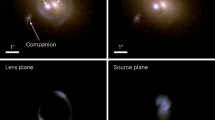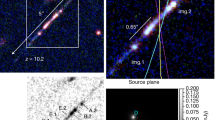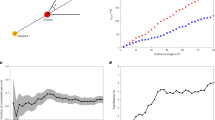Abstract
The problem of QSO-galaxy associations has been analysed1,2 by taking into account different classes of QSOs with the conclusions that: (1) the strong excess of 3C QSOs near bright galaxies3 is not confirmed by larger QSO samples, which do not show any tendency towards QSO-galaxy associations, so that the 3C QSOs appeared as a statistical fluctuation1. (2) Amongst various classes of QSOs, optically variable (OV) QSOs from a list of 41 objects4 showed a significant excess of QSOs near galaxies2. But to be considered as a physical effect this excess needed confirmation from a larger sample of QSOs. Canizares5 has used the possibility of gravitational lens effects on QSOs caused by stars in galactic haloes to explain the presence of numerous QSOs near bright galaxies6, whose statistical significance is quite controversial (see refs 7–11). Canizares attributed to such QSOs one physical characteristic--their optical variability caused by the relative motions of the Earth and of the star acting as a gravitational lens. As these theoretical considerations gave a new insight on our previous statistical study, we decided to consider a larger sample of OV QSOs. We now present this new analysis and discuss the results in the light of Canizares' considerations.
This is a preview of subscription content, access via your institution
Access options
Subscribe to this journal
Receive 51 print issues and online access
$199.00 per year
only $3.90 per issue
Buy this article
- Purchase on SpringerLink
- Instant access to full article PDF
Prices may be subject to local taxes which are calculated during checkout
Similar content being viewed by others
References
Nieto, J.-L. Astr. Astrophys. 70, 219–226 (1978).
Nieto, J.-L. Astr. Astrophys. 74, 152–155 (1979).
Burbidge, E. M., Burbidge, G. R., Solomon, P. M. & Strittmatter, P. A. Astrophys. J. 170, 233–240 (1971).
Grandi, S. A. & Tifft, W. G. Publ. Astr. Soc. Pacif. 86, 873–884 (1974).
Canizares, C. R. Nature 291, 620–623 (1981).
Arp, H. C. Astrophys. J. 250, 31–42 (1981).
Wills, D. Phys. Scr. 17, 333–337 (1978).
Nieto, J.-L. Nature 270, 411–412 (1977).
Burbidge, G. R. Nature 282, 451–455 (1979).
Browne, I. W. A. Astrophys. J. Lett. 263, L7–L8 (1982).
Webster, A. Mon. Not. R. astr. Soc. 200, 47P–49P (1982).
Nieto, J.-L. & Seldner, M. Astr. Astrophys. 112, 321–329 (1982).
Hewitt, A. H. & Burbidge, G. R. Astrophys. J. Suppl. 43, 57–158 (1980).
Turner, E. L. Astrophys. J. 242, L135–L139 (1980).
Young, P., Gunn, J. E., Kristian, J., Oke, J. B. & Westphal, J. A. Astrophys. J. 241, 507–520 (1980).
Young, P., Gunn, J. E., Kristian, J., Oke, J. B., Westphal, J. A. Astrophys. J. 244, 736–755 (1980).
Weedmann, D. W., Weymann, R. J., Green, R. F. & Heckman, T. M. Astrophys. J. Lett. 255, L5–L9 (1982).
Weymann, R. J. et al. Nature 285, 641–643 (1980).
Author information
Authors and Affiliations
Rights and permissions
About this article
Cite this article
Bacon, R., Nieto, JL. Optical variability of QSOs and gravitational lenses in galactic haloes. Nature 301, 400–402 (1983). https://doi.org/10.1038/301400a0
Received:
Accepted:
Issue date:
DOI: https://doi.org/10.1038/301400a0



